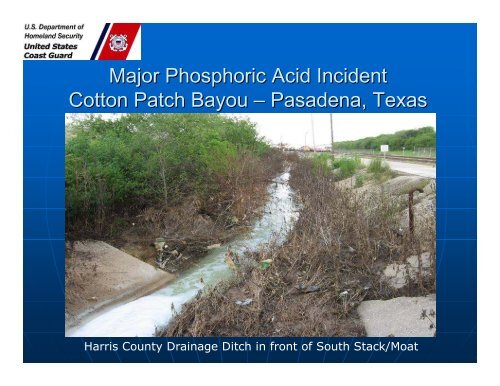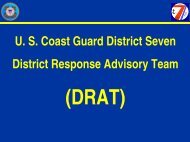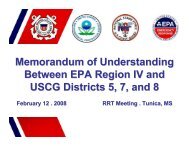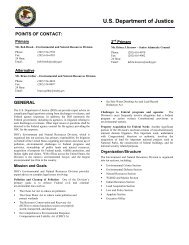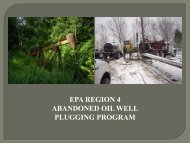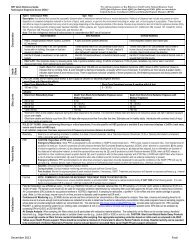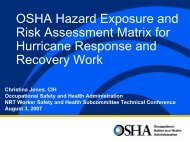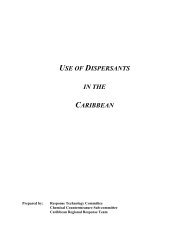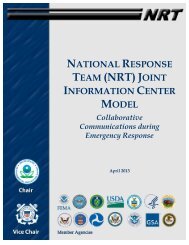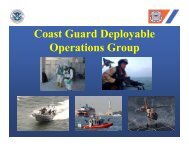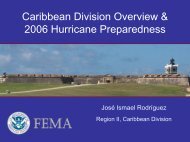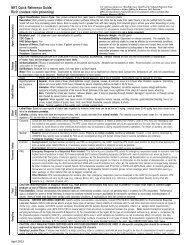Major Phosphoric Acid Incident - U.S. National Response Team (NRT)
Major Phosphoric Acid Incident - U.S. National Response Team (NRT)
Major Phosphoric Acid Incident - U.S. National Response Team (NRT)
- No tags were found...
Create successful ePaper yourself
Turn your PDF publications into a flip-book with our unique Google optimized e-Paper software.
One of the two ponds on top of the South Stack:Pond #2 covered 26 Acres and Pond #5 covered 44 acres.
North Wall of the South Gypsum Stack looking east.Stack height is approximately 120 feet.
This is the “moat” on the north side of the South Stackfacing east.This moat holds approximately 25 million gallons ofwastewater (pH2).
South Stack Moat/Retaining Wall SeepageHarris County drainage ditch
Controlled Point of Release from SouthStack Moat to Harris County Drainage DitchAttempt to use Soda Ash toadjust pHReaction of Soda Ash and pH2wastewater in the ditch
Gypsum Stack Management -101Outer rimRim wallBeachWastewater PondStack wallRim DitchStack baseMoatMoat/stack retaining wall
Estimated Timeline of Events16 August 2007 Tropical Storm Erin caused excessiverainfall which led to failure of a portion ofthe moat retaining wall at the SouthGypsum Stack. Wastewater levels inponds and moats greatly exceededrecommended levels Agrifos began controlled release intoHarris County Drainage Ditch Agrifos supposedly notified TCEQ of theemergency situation and the pumping ofthe wastewater into Cotton Patch Bayou
Estimated Timeline of Events~1 September 2007 The correct office in TCEQ received thenotification made in mid-August~4 September 2007 TCEQ investigated the situation at the facilityand was alarmed that Agrifos was stillreleasing the wastewater into the countyditch via two 10” pipes
Estimated Timeline of Events~ 5 September 2007 TCEQ notified USCG of situation USCG FOSC – Captain William Diehl, toldAgrifos to discontinue release into the bayouas violation of Clean Water Act Agrifos claimed that the moat wall at thebase of the South Stack would failcatastrophically if release was stopped,resulting in catastrophic release of 25 milliongallons of wastewater from moat
Timeline of Events6 September 2007 CG FOSCRs met with TCEQ and Agrifos todetermine extent of situation, explainrequirements for notification and response USCG & TCEQ issued initial responseobjectives to Agrifos including establishingan ICS organization, decreasing release byhalf immediately, conducting an assessmentof moat wall integrity, and begin monitoringpH levels of downstream waterways CG FOSC notified EPA Region VI andrequested technical assistance; CG GulfStrike <strong>Team</strong> assistance also requested
Timeline of Events7 September 2007 Initial Unified Command (CG, EPA, TCEQ,RP) Objectives Set EPA & RP engineers conducted assessmentof structural integrity of moat wall; bothassessments concluded wall would not failcatastrophically Controlled release from moat into countyditch was secured CG issued press release
Initial Unified Command ObjectivesSafety of personnel and the publicStop controlled releaseIdentify all possible solutions to deal withwastewater to get out of crisis situation –storage, treatment, disposal and preventadditional releases – controlled oruncontrolledPrevent catastrophic failure of gypsumstacksAssess impact to the environment
Timeline of Events8 September 2007 GST led a unified Storage Work Group(SWG) effort to develop alternatives forimmediate storage of untreated wastewater Learned of contractual arrangement betweenAgrifos and Exxon-Mobil for Stack 4wastewater management SWG findings resulted in shifting emphasison treatment/disposal options forwastewater CG/EPA FOSCs requested “water balance”process and worksheet from RP to measurenet gain/loss of wastewater
Timeline of Events9 September 2007 First water balance presented at UC meeting CG/EPA FOSCs requested written riskassessment from gypsum stack expert,Ardaman Associates, Inc. from the RP onstructural integrity of stacks, moats, andponds CG FOSC issued Exxon-Mobil a NOFI RP VP met with FOSCs and SOSC to briefthem on financial status of the company Treatment & disposal work group effortscontinued to work on on-site and off-siteoptions
Timeline of Events10 September 2007 Moat wall maintenance/repair workcontinued to bolster structural integrity Water balance refinement continued – needto “lose” 1M gallons/day in addition to 800Kplant usage and 600K evaporation/day togain on situation; 3-5M 3gallons a day shouldbe objective to return levels to “normal” CG/EPA/State held initial RRT meeting Aradman Associates drafted initial report oncritical situation of gypsum stacks
Timeline of Events11 September 2007 Ardaman Associates briefed UC on criticalsituation of gypsum stacks and riskassociated with additional rain/wind events CG/EPA FOSCs held second RRT meeting onresponse options & discussed issuing a jointletter to Agrifos directing them to prevent acatastrophic stack failure Weather situation worsened with potentialtropical storm activity & actual 1-2” 1 rain/day
Timeline of Events11 September 2007 (continued) CG FOSC requested GST chemical pump loadas contingency since RP did not have apumping contingency plan developed CG FOSC issued letter to Agrifos & Exxon-Mobil directing them to prevent catastrophicfailure of the stacks (without EPA & State)and required the RP to make notifications toneighboring facilities Multiple significant leaks reported on Stack#4 (North Stack) near top of stack
Tropical Storm Humberto’s leading edge< 12” freeboardRim ditch breakthroughCaptain DiehlSouthwest corner of the South Stack looking south atdowntown Pasadena Texas
Timeline of Events12 September 2007 RP indicated intent was to let moats overflowbut not to pump intentionally; activemonitoring of all stacks, ponds & moatsincreased Final RRT meeting; FOSCs reiteratedcriticality of situation especially w/worseningWx; determined EPA as lead federal agency Tropical Storm (TS) warning issued forHouston Emergency <strong>Response</strong> efforts shifted todealing with TS crisis at Planning Meeting
Timeline of Events12 September 2007 (continued) EPA issued CERCLA Order to RP to preventstack failure – gave some leeway forcontrolled release GST pump load arrived & staged @ SectorHouston-Galveston Agrifos commenced controlled release intocounty ditch with one 10” and one 8” 8 line;pumping from top of stacks as well; notifiedneighboring facilities and waterway uses. UC made adjustments to IAP to deal w/TS
Agrifos began pumping pond water directly from top of thestack into the moat belowRim ditch wall and ditch integrity completely compromised
South Stack moat overflow at engineered low point
Just before Hurricane Humberto…The other end of the rainbowon top of the South StackOne end of the rainbowover the North Stack (#4)
Timeline of Events13 September 2007 Hurricane Humberto “missed” Pasadena tothe east by 10 miles – no rain fell at the site EPA FOSC ordered RP to stop controlledrelease from 8” 8 line @ 0200 RP released between 17-19M 19M gallonsovernight; freeboard in stack ponds greatlyimproved <strong>Response</strong> shifted back to more deliberateoperations and pursuit of options to get outof critical phase and back to a managedemergency GST pump load released
Timeline of Events14-16 16 September 2007 Work group efforts continued to implementtreatment and fertilizer product options Work continued on repairing moat seeps (11areas completed) Ship channel traffic resumed upstreammovement helping to disperse acid plume Water levels in ponds and moats steadilyimproved; EPA OSC ordered RP to ceasepumping from remaining 10’ line 15September once target levels were reached GST released and returned to Mobile
Environmental Impact•Wildlife impact was minimal•Vegetation was dead in Cotton PatchBayou•pH readings in the Ship Channel werelower than normal and stratified north &south of the outfall; once ships transitedthe area, pH readings improvedsignificantly
<strong>Incident</strong> Challenges Volume of wastewater: 25-170 million gallonspotential Agency understanding of the fertilizer and gypsumstack processes and current managementpractices of Agrifos – learned something newevery day RP’s s lack of objective processes, procedures,planning to “manage” the wastewater RP’s s apparent lack of understanding of agencyconcerns and roles – CERCLA, CWA Realistic options for dealing with the extremeconditions and pH2 water Weather -Tropical Storm/Hurricane Humberto
<strong>Incident</strong> SuccessesAgency cooperation at the field level wasoutstanding, ensuring a unified state, CG, EPAposition. NOAA SSC involvement was critical toincident successes.The RP hired a spill management company to runthe incident and fill key roles (they had no ICSexperience)RRT engagement/involvement was proactiveWritten directives (CG letter & CERCLA order) tothe RP clarified agency expectations and helpeddrive the responseThe RP’s s personnel were very cooperative in tryingto find solutions, prepare contingency plans, andput objective monitoring processes in place tomeasure wastewater levels
<strong>Incident</strong> SuccessesAn uncontrolled stack/moat failure was avertedand the controlled release was stopped oncealternatives were identified and put into effectEnvironmental impact was minimized; an effectivesampling and monitoring plan was implementedEPA assumed lead and issued a CERCLA Orderwhich clarified the federal role – transition fromjoint lead to EPA-lead was smoothCreative solutions (e.g., use the wastewater toproduce a low-grade fertilizer product) werepursued and not discountedWorking within the ICS Unified Command provedchallenging (e.g., can the UC make implementdecisions that may be technically illegal) at timesbut imperative to overall issue resolution
Questions?


